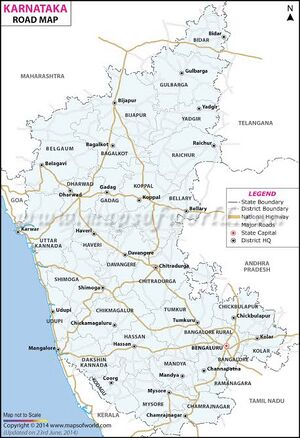Kolar Karnataka
| Author:Laxman Burdak, IFS (R) |


Kolar (कोलर)is a city and district in the Indian state of Karnataka. It is the headquarters of Kolar District and is known for gold mining. The city is the location of the Someshwara temple and the Kolaramma temple. Kolaramma is considered as goddess of city of Kolar.
Variants
- Kolar District
- Kolar (कोलर) (मैसूर) (p.237)
- Kolahala Pura/Kolahalapura (कॊलाहलपुर)
Origin
Kolar is said to have get name from Kolahala (कॊलाहल).
Location
Kolar is located at 13.13°N 78.13°E. It is located at a distance of about 70 kms from Bengaluru and 50 km from Bangalore International Airport 32 kms from Kolar Gold Fields. The city is located on the southern maidan (plains) region of Karnataka.
History
The Western Gangas sovereignty lasted from about 350 to 550 CE, initially ruled from Kolar as their Capital City. The founder of the Western Ganga dynasty was Konganivarman Madhava, who built Kolar as his capital around 350 and ruled for about twenty years. He succeeded by his son Madhava I. Kolar, the headquarters of the Kolar district, was earlier known as Kuvalalapura, also known as Kolahala Pura. Historically, Kolar is said to be associated with the epic age, which recalls many legends associated with Avani in Mulbagal Taluk, which was also called Avani Kshetra.
It was once known as Avantika-Kshetra, a sacred place in Kolar district in Karnataka State. It was famous for its religious establishments from ancient times. It was once known as Aavanya which was under the Ganga prince Madhava Muttarasa, who governed several districts.
In about A.D 890, its earliest grant relates that Tribhuvana Kartara Deva, who held the title of Kali Yuga Rudra, ruled over the Avaniya Thana for 40 years. During this period he constructed 50 temples and two large tanks. Maharshi Valmiki, author of the epic Ramayana, lived here. The legend goes further to establish that Sita, after being sent to exile, gave birth to her twins Lava and Kusha at Avani. The Avani continued to survive as a religious establishment from the 9th to 11th centuries. There are temples dedicated to Lord Rama.
The hill to the west of Kolar, called the Shatasringa Parvata or 'Hundred-Peaked Mountain' is 'Antharagange', associated with the story of Parasurama and his fight with King Kartaviryarjuna over Surabhi, the divine cow. As the story goes, King Kartavirya Arjuna (Sahasrarjuna) and his army visited Jamadagni, Parasurama's father, when the king demanded the magical cow from Jamadagni. When Jamadagni refused, the King sent his soldiers to take the cow, but Parashurama killed the entire army and the king with his axe. In return, the princes beheaded Jamadagni. Thus, Parasurama took an oath to behead the entire Kshatriya race, which is said to have taken place on the hills. It is said that the Kolahala on the death of Kartaviryarjuna gave its name to the town, which later become Kolar.
कोलर
विजयेन्द्र कुमार माथुर[1] ने लेख किया है ...कोलर बैंगलोर से 60 मील दूर है. मैसूर के प्रसिद्ध गंगवंशीय राजाओं की राजधानी लगभग 700 वर्षों तक यहां रही और 1004 ई. में उनका राज्य समाप्त होने पर कोलर से भी राज्यश्री विदा हुई. कोलर अपनी सोने की खानों के लिए प्रसिद्ध है. शायद यही प्रदेश प्राचीन काल में सुवर्णगिरी कहलाता था.
In Mahabharata
Kolahala (कॊलाहल) (Mountain) is mentioned in Mahabharata (I.57.32)
Adi Parva, Mahabharata/ Book I Chapter 57 mentions Uparichara Vasu, conquered kingdom of Chedi and his sons planted kingdoms and towns. Kolahala (कॊलाहल) (Mountain) is mentioned in Mahabharata (I.57.32). [2].... And as the King (Vasu) coursed through the upper regions, he was called Uparichara. And by his capital flowed a river called Suktimati. And that river was once attacked by a life-endued mountain called Kolahala maddened by lust. And Vasu, beholding the foul attempt, struck the mountain with his foot. And by the indentation caused by Vasu's stamp, the river came out (of the embraces of Kolahala). But the mountain begat on the river two children that were twins. And the river, grateful to Vasu for his having set her free from Kolahala's embraces, gave them both to Vasu. And the son was made the generalissimo to his forces by Vasu, that best of royal sages and giver of wealth and punisher of enemies. And the daughter called Girika, was wedded by Vasu.
External links
References
- ↑ Aitihasik Sthanavali by Vijayendra Kumar Mathur, p.
- ↑ पुरॊपवाहिनीं तस्य नदीं शुक्तिमतीं गिरिः, अरौत्सीच चेतना युक्तः कामात कॊलाहलः किल (I.57.32)

